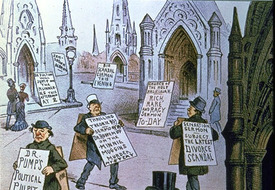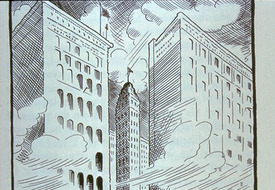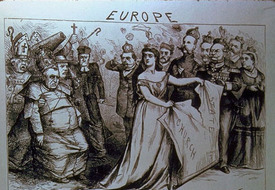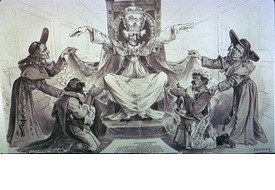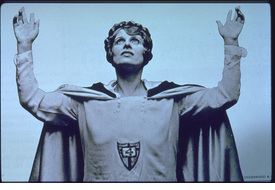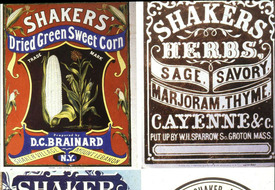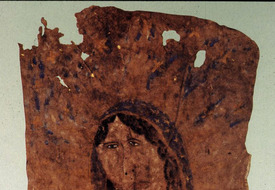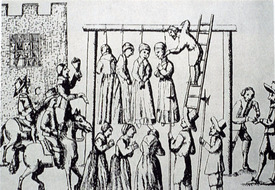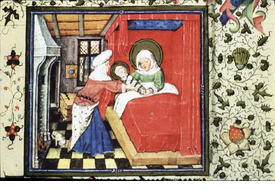Cartoon Poking Fun at Muckracking Ministers, 1883
Image ID: 4212
Collection: Roland Marchand
Topic(s): Religion, Social Gospel and Missions
Region(s): United States
CA Standard(s): 11.3 - The role of religion in the founding of America and its lasting moral, social, and political impacts, and issues regarding religious liberty.
National Standard(s):
Card Text: Cartoon poking fun at muckracking ministers who, ostensibly to wage campaigns against vice, offer the public a Sabbath melodrama instead of more sober forms of worship. 1883.
Citation: Puck, Oct. 3, 1883. In Mary Cable and the Eds. of American Heritage, American Manners & Morals, 1969, p. 247.
11.3.1
'Nearer My God to Thee' 1913
Image ID: 4213
Collection: Roland Marchand
Topic(s): Religion, Social Gospel and Missions, Arts and Architecture
Region(s): United States
CA Standard(s): 11.3 - The role of religion in the founding of America and its lasting moral, social, and political impacts, and issues regarding religious liberty.
National Standard(s):
Card Text: "Nearer My God to Thee," 1913. A tiny church is overwhelmed by the enormous skyscrapers of capitalist America.
Citation: Copyright holder unknown. Art Young drawing. In The Masses, Dec. 1913. In Echoes of Revolt: The Masses, 1911-1917, Chicago, 1966, p. 222.
11.3.1
Irish Catholic Threat to the Separation of Church and State as Dangerous to Freedom in the U.S., 1870
Image ID: 4226
Collection: Roland Marchand
Topic(s): Religion, Anti Catholic Nativism
Region(s): United States
CA Standard(s): 11.3 - The role of religion in the founding of America and its lasting moral, social, and political impacts, and issues regarding religious liberty.
National Standard(s):
Card Text: The cartoonist sees the supposed Irish Catholic threat to the separation of church and state as dangerous to freedom in the U.S., 1870.
Citation: Thomas Nast cartoon. Harper's Weekly, Feb. 19, 1870.
11.3.3
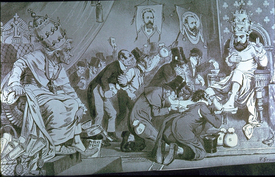
Cartoon: 'Boycotting the Pope'
Image ID: 4232
Collection: Roland Marchand
Topic(s): Religion, Anti Catholic Nativism
Region(s): United States
CA Standard(s): 11.3 - The role of religion in the founding of America and its lasting moral, social, and political impacts, and issues regarding religious liberty.
National Standard(s): The Development of the Industrial United States (1870-1900)
Card Text: "Boycotting the Pope...His Holiness the Pope is in a bad way. His most faithful Irish subjects have gone back on him. They have told Leo [XIII] in very plain terms that they will take all the theology he can give them, but they decline to have it adulterated with politics. They have transferred their homage to Mr. Parnell. But it isn't the loss of allegiance that is bothering the Pope so much as it is the Peter's Pence that goes with it." Message: The pro-labor Pope is hypocritical as well as dangerous.
Citation: F. Graetz cartoon. In Mary and Gordon Campbell, The Pen, Not the Sword, Nashville, TN, 1970, p. 135.
Cartoon: 'A Business Alliance'
Image ID: 4234
Collection: Roland Marchand
Topic(s): Religion, Anti Catholic Nativism
Region(s): United States
CA Standard(s): 11.3 - The role of religion in the founding of America and its lasting moral, social, and political impacts, and issues regarding religious liberty. , 8.12 - The transformation of the American economy and the changing social and political conditions…in response to the Industrial Revolution
National Standard(s):
Card Text: "A Business Alliance." Pope Leo XIII (at center) says, "Bless you, my children! I think we can work together nobly in America." Pictured with him are two cardinals and two strikers. In the note at the bottom Cardinal Manning states, "I have read with great assent Cardinal Gibbon's document in relation to the Knights of Labor." Anti-Catholic propaganda.
Citation: Joseph Keppler cartoon. Judge Magazine. In Mary and Gordon Campbell, The Pen, Not the Sword, Nashville, Tenn., 1970, p. 139.
Aimee Semple McPherson, Los Angeles
Image ID: 4260
Collection: Roland Marchand
Topic(s): Religion, Revivalism since 1880
Region(s): United States
CA Standard(s): 11.3 - The role of religion in the founding of America and its lasting moral, social, and political impacts, and issues regarding religious liberty. , 11.5 - Major political, social, economic, technological, and cultural developments of the 1920s.
National Standard(s):
Card Text: Aimee Semple McPherson, a combination of sensualism and splendor, from her $1,500,000 Angelus Temple in Los Angeles.
Citation: Copyright holder unknown. Underwood & Underwood photo. In Eds. of American Heritage, The American Heritage History of The 20's and 30's, 1970, p. 139.
11.3.2, 11.5.7
Shaker Labels for Processed Food
Image ID: 8641
Collection: Karen Halttunen
Topic(s): Religion, Shakers
Region(s): United States
CA Standard(s): 11.3 - The role of religion in the founding of America and its lasting moral, social, and political impacts, and issues regarding religious liberty.
National Standard(s):
Card Text: Shaker labels for processed food, which was wholesome when typical canned foods were unsafe
Citation: The Shaker Museum & Library, 88 Shaker Museum Rd, Old Chatham, NY 12136
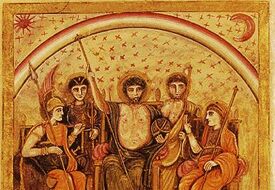
Meeting of Roman Gods, 5th c. AD/CE, the Roman Virgil
Image ID: 10911
Collection: Joan Cadden
Topic(s): Religion, Mythology
Region(s): Europe
CA Standard(s): 6.7 - The geographic, political, economic, religious, and social structures during the development of Rome
National Standard(s): Classical Traditions, Major Religions and Giant Empires, 1000 BCE-300 CE
Card Text: The Meeting of the Gods, according to the Romans. From left, Minerva(?), Mercury, Jupiter (Jove), Mars and Juno. From the Roman Vergil, one of the oldest texts of Vergil's "Aeneid," written 29-19 BCE during the collapse of the Roman Republic. Made in Rome in the 5th c. AD/CE, the Roman Virgil is one of only three surviving illustrated manuscripts of classical literature, with the Vergilius Vaticanus and the Ambrosian Iliad. This precious manuscript influenced the development of medieval art.
Citation: Deorum consensus a Jove convocatus. Vergilius Romanus, The Roman Vergil. Biblioteca Apostolica Vaticana, the Vatican Library, Cortile del Belvedere, 00120 Città del Vaticano, Vatican City State, EUROPE. Cod. Vat. lat. 3867. Folio 234 verso. http://www.vatican.va/ library_archives/index.htm.
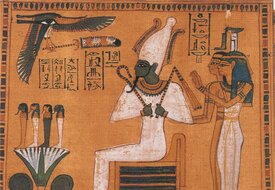
Osiris on the Throne Surrounded by Isis, Nephthys and Horus
Image ID: 11182
Collection: Joan Cadden
Topic(s): Religion, Mythology, Arts and Architecture
Region(s): Africa
CA Standard(s): 6.2 - The geographic, political, economic, religious, and social structures of the early civilizations of Mesopotamia, Egypt, and Kush
National Standard(s): Early Civilizations and the Emergence of Pastoral Peoples, 4000-1000 BCE
Card Text: Osiris on the throne surrounded by Isis, Nephthys and Horus, the son of Isis. A fragment of the Egyptian Book of the Dead. With the counsel of Isis and Nephthys, Osiris judged the dead, deciding who proceeded into everlasting life or damnation. Here Horus in falcon form brings a deceased before the shrine of Osiris. The four sons of Horus stand on a lotus flower growing out of the waters beneath the throne. 1240 BCE.
Citation: 9 online. E.A. Wallis Budge, trans., "Egyptian Book of the Dead, The Papyrus of Ani," (The Medici Society, 19-23 White Lion St, Islington, London N1 9PD England, UNITED KINGDOM, 1913).
Madonna on Buffalo Robe, 1675
Image ID: 12825
Collection: Alan Taylor
Topic(s): Religion, Colonies
Region(s): United States
CA Standard(s): 5.4 - Political, religious, social, and economic institutions that evolved in the colonial era. , 7.11 - political and economic change in the sixteenth, seventeenth, and eighteenth centuries (the Age of Exploration, the Enlightenment, and the Age of Reason)
National Standard(s): Colonization and Settlement (1585-1763)
Card Text: Madonna on buffalo robe, New Mexico, c. 1675. A Native artist gave Pueblo features to this rare hide painting of the Virgin Mary.
Citation: Elisabeth Waldo-Dentzel Collection, MultiCultural Music and Art Foundation of Northridge (MCMAFN), PO Box 280101, Northridge, CA 91328. Also, Southwest Museum, Autry National Center, 4700 Western Heritage Way, Los Angeles, CA 90027-1462.
Men Hanging Witches, England, 1650
Image ID: 12840
Collection: Alan Taylor
Topic(s): Religion, Colonies
Region(s): United States, Europe
CA Standard(s): 5.4 - Political, religious, social, and economic institutions that evolved in the colonial era. , 7.11 - political and economic change in the sixteenth, seventeenth, and eighteenth centuries (the Age of Exploration, the Enlightenment, and the Age of Reason)
National Standard(s): Colonization and Settlement (1585-1763), The Emergence of the First Global Age, 1450-1770
Card Text: Men hanging women "witches," 1650, England. Apparently there is no surviving image of the execution of American "witches." Engraving.
Citation: Newcastle-upon-Tyne, 1649-50. Illustration in Ralph Gardiner, "England's Grievance Discovered, In Relation to the Coal Trade" (London, 1655). Peabody Essex Museum, East India Square, Salem, MA 01970-3783. Also Stapleton Collection, Bridgeman Art, Thorp Arch, Wetherby, West Yorkshire LS23 7RR UNITED KINGDOM.
Book of Hours of Catherine of Clèves, Blessed Virgin Mary, c. 1440
Image ID: 10755
Collection: Joan Cadden
Topic(s): Religion, Illuminated Manuscripts, Medieval
Region(s): Europe
CA Standard(s): 7.6 - The geographic, political, economic, religious, and social structures of the civilizations of Medieval Europe
National Standard(s): Intensified Hemispheric Interactions 1000-1500 CE
Card Text: Birth of the Blessed Virgin Mary. Detail of central scene. 5. From the Book of Hours of Catherine of Clèves, containing the prayers and litanies of the Mass in Latin, decorated with 157 lavishly colored and gilded illuminations by the Dutch artist, the Clèves Master, c. 1440, in Gothic style. It may be the greatest achievement of northern European illumination. North Rhineland.
Citation: Morgan Library & Museum, 225 Madison Ave at 36th St, New York, NY 10016. Online at www.themorgan.org.
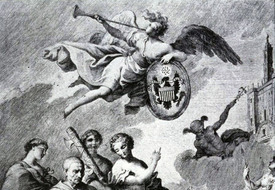
Elven, George Washington Giving the Laws, c. 1800
Image ID: 7913
Collection: Karen Halttunen
Topic(s): Eighteenth Century, Washington, Politics & Government, American Revolution, Ancient History, Art Style, Columbian Exchange, Cooption of styles, Early National Period, Founding Myths, Greece Ancient, Holy Land, Mythology, National Events, Numinous, Personalization, Presidents, Propaganda, Religion, Roman, Symbols, Women's image
Region(s): United States
CA Standard(s): 8.6 - The divergent paths of the American people from 1800 to the mid-1800s...with emphasis on the Northeast. , 8.1 - Major events preceding the founding of the nation and the development of American constitutional democracy, 5.6 - The course and consequences of the American Revolution, 5.7 - People and events associated with the development of the U.S. Constitution and it's significance as the foundation of the American republic
National Standard(s): Revolution and the New Nation (1754-1820s)
Card Text: J.P. Elven, "Washington Giving the Laws to America," c. 1800. The deification of George Washington. An elderly man wearing a Roman toga, representing Washington, holds a stone tablet entitled "The American Constitution." He is surrounded by allegorical figures. Britannia and her lion sit at his feet while female figures symbolizing government, industry and the arts move in the background. The Greek gods Athena (Minerva) and Hermes (Mercury) are placed before a temple in the right background, as the archangel Gabriel, flying above the scene, blows his trumpet and carries a shield emblazoned with the American emblem.
At the time this work was created, important figures were commonly shown in allegorical settings. Greece and Rome had melded to symbolize a Golden Age of humankind. Competent artists were well versed in the ancients and mythology, and this engraving depicts Washington as a Roman, a symbol of a new age of republican leadership and the struggle for independence. Dressing a people's president as an emperor or tyrant personified to the revolutionary mind the heroic, noble ancient world, not the literal one.
In classical garb, Washington holds a stylus and a slab engraved "The American Constitution." He is flanked by Justice, who holds the fasces, a bundle of rods with a projecting axe blade, the Roman symbol of authority and the power of the law; and by Truth, holding her familiar mirror. Liberty was often shown as attended by Peace, Justice, and Truth.
At Washington's right, Liberty restrains a lion, the symbol of the British Empire, the oppressor defeated by Washington: She also holds back any attempt by the new nation to build an empire of its own. Above Washington, the angel Gabriel symbolizes God's power and judgment, sounding the call of freedom represented by the American coat of arms.
A body of water separates Washington from a group of figures at right including Minerva, the Roman goddess of wisdom and war, wearing armor and carrying a shield and spear. With her are two female figures, one holding a palette and brushes representing the arts. Above them in a bank of clouds is Mercury, the Roman god of commerce and messenger of the gods. The Romans historically offered the first fruit of a tree to Mercury, asking his blessing on any new enterprise. Mercury points toward the temple rising behind him, a symbol of the Kingdom of God. In the foreground a well-muscled Hercules in an animal skin and a crown of laurel reclines in his godly strength. Engraving and etching. 15 x 7 cm.
Citation: "Washington Giving the Laws to America," United States, c. 1800. Photograph and first text: Library of Congress Prints and Photographs Division, Washington, DC 20540. LC-DIG-ds-05302. https://www.loc.gov/item/2014645020/. Second text: "An Important Recently Discovered Tribute to George Washington and America, 'George Washington Giving the Laws to America,' New England. Anonymous, c. 1800." Copyright 2003-19 Antique Associates, 73 Main St, PO Box 129W, West Townsend, MA 01474. https://www.aaawt.com/html/sold/136.html. All rights reserved. Oct 22, 2021.
